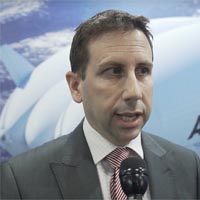
 Front view of Airlander hybrid lighter-than-air aircraft
Front view of Airlander hybrid lighter-than-air aircraft
AIRLANDER: The Birth of Sustainable Air Travel
Has the 'Age of the Airship' passed or do 21st century materials and environmental concerns mean we're about to enter the 'Age of Slow Travel'?
If the latter half of the 20th century was the heyday of "fast food" and "fast travel" will a new environmental consciousness and responsible resource husbandry bring a slower pace of travel as well? Will the emerging phenomenon of "flight shaming" that caused Greta Thunberg to ride a sailboat across the Atlantic -- twice -- to demonstrate her commitment to reducing her personal carbon footprint, inspire others to find alternatives to jet travel? Will we see the return of lighter-than-air "ships" become a serious option, not just for passenger travel but also logistics movement, delivering goods to out-of-the-reach places? That is what Tom Grundy and his team at Hybrid Air Vehicles in England are banking on as they begin the construction of the next generation Airlander LTA. Actually LTA is a bit of a misnomer when applied to the Airlander. Technically speaking this whale of an aircraft measuring 299 feet in length, isnt actually "lighter-than-air." It is designed to use its aerodynamic fat-wing shape to generate some 40% of its lift, relying on non-combustible helium, for the other 60%. This means when it stops moving, it will slowly sink to the ground. In my 35-plus minute discussion with H.A.V. CEO Tom Grundy, he explains the 21-century technology behind the Airlander, which was originally developed as an unmanned surveillance platform for the U.S. military, equipped with a host of intelligence collection equipment and able to operate weeks-on-end at altitudes upwards of 30,000 ft. When the U.S. Army cancelled the contract, the company bought the prototype back from the government and returned it to England, intent on finding new applications for its already energy efficient design. As Grundy explained to me, even with its four diesel engine-powered ducted fan propulsion system, it was already 75% more efficient in terms of its CO2 emissions per payload capacity than its more conventional airplane rivals. When the company introduces its next generation model now in development, those will approach 90% using a combination of diesel and electric propulsion. Eventually, using a mix of hydrogen fuel cells, solar panels and batteries, the goal is to have Airlander successors be 100% electrically-powered. At the moment, the company has some 17 letters of intent from potential customers, most of whom are interested in the logistics capabilities of the craft, although Grundy does see future Airlanders transporting passengers over what he describes as "short-to-medium" haul routes of upwards of 200-300 miles. This may run him into competition with other electric airplane developers eyeing the same markets. But hes counting on a segment of "experiential travelers" who, like train travelers, prefer a more leisurely pace of getting from A-to-B as the countryside unfolds below huge vista windows in a salon-like setting.
If you enjoy these interviews, please consider becoming a Patreon supporter for as little as $3 a month. Check the button below to learn more.
First Published: 2020-02-13
Pages Viewed: 23868

EV WORLD.COM
Future In Motion™ Podcast
Tom Grundy
The Complete MP3 File Is Available to Patron Supporters